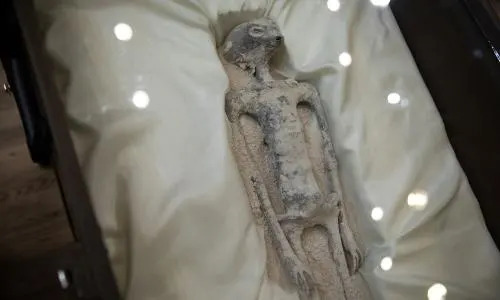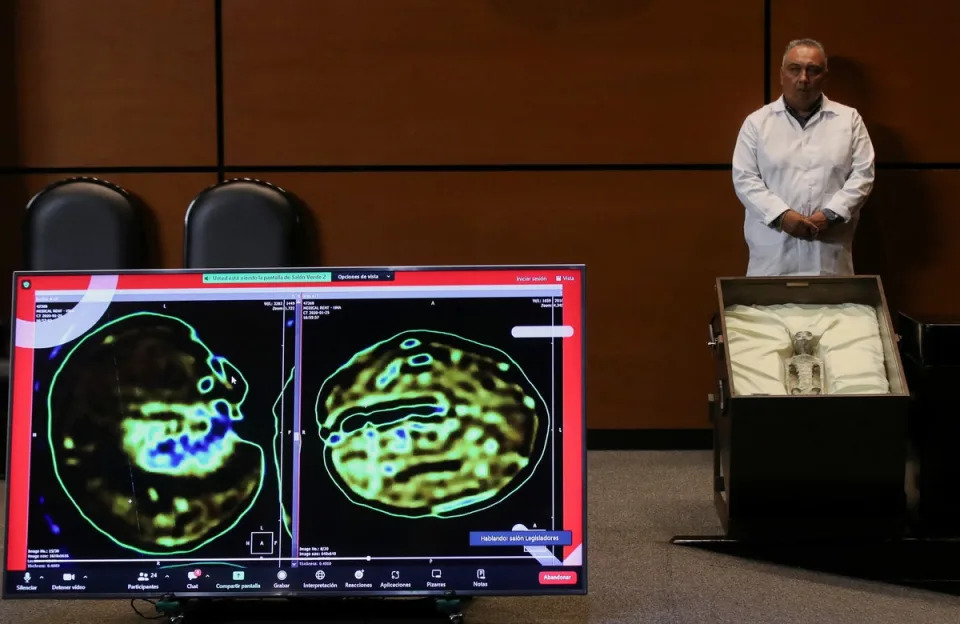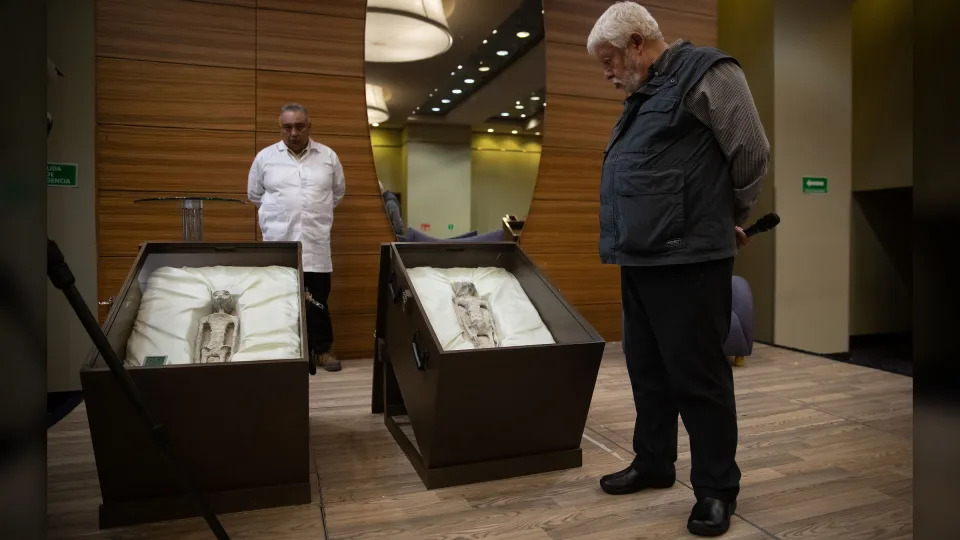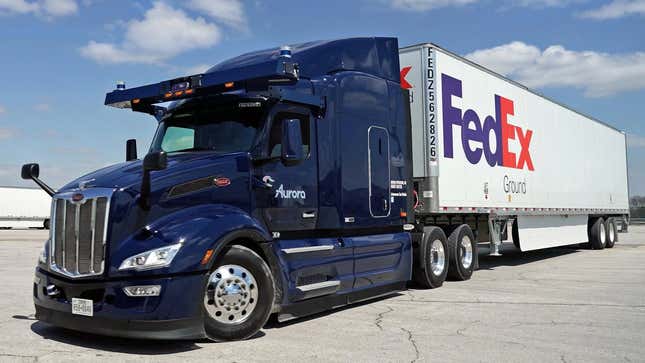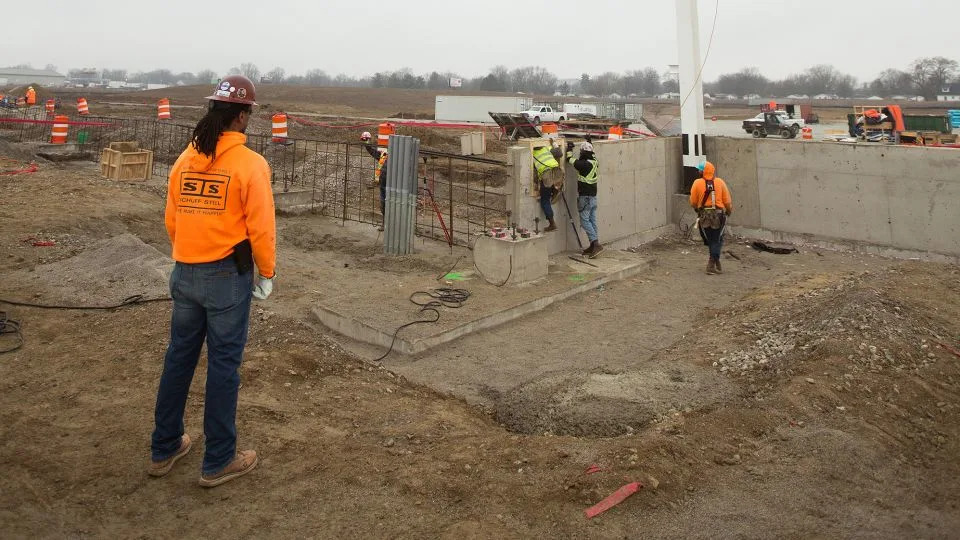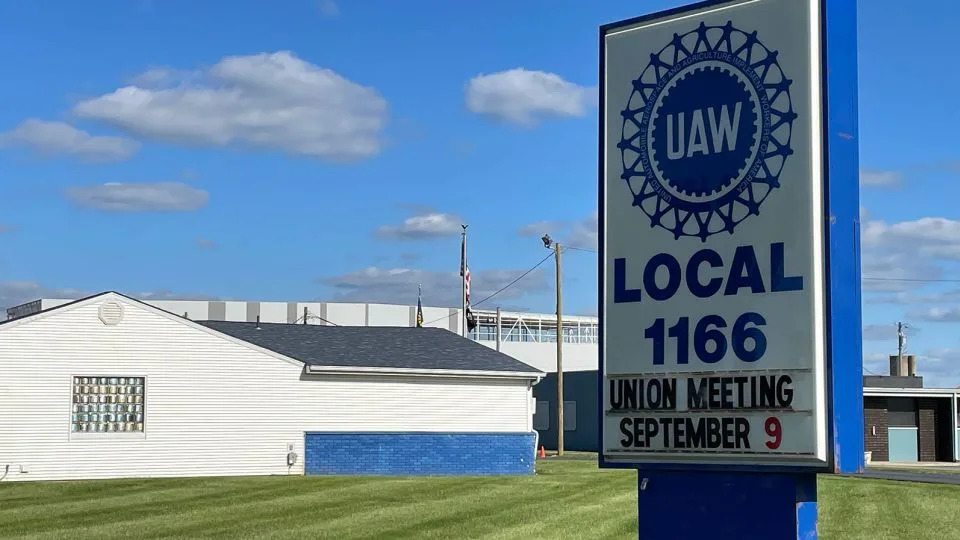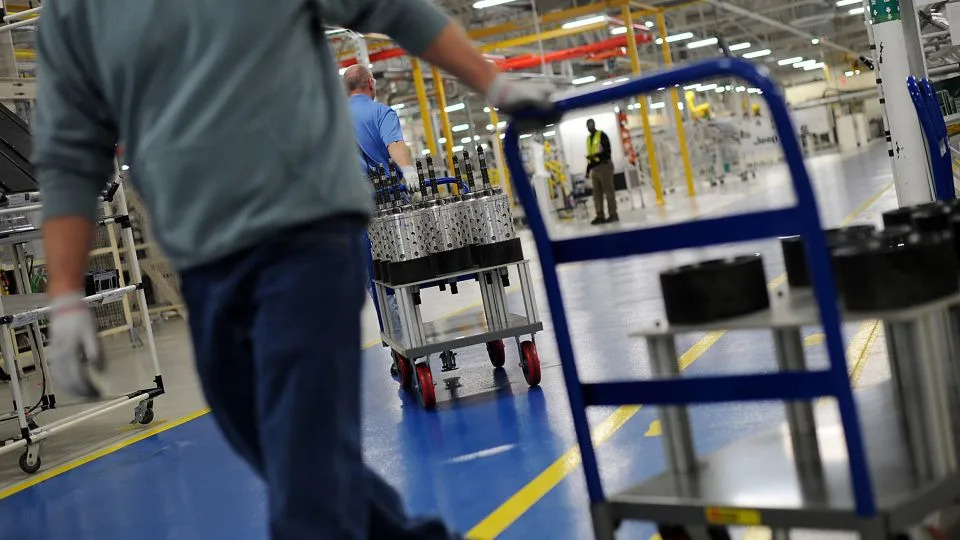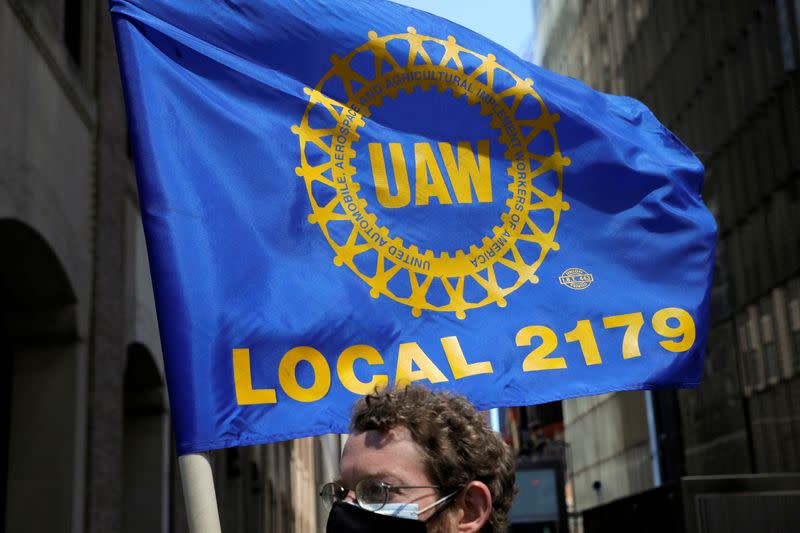How the extreme rainfall may be connected to climate change and how to prepare for future storms
Ben Adler
·Senior Editor
Thu, September 14, 2023
People look for survivors in Derna, Libya. Sept.13, 2023.
(Yousef Murad/AP Photo)
Storm Daniel has taken an extraordinary toll on Libya, where the estimated death toll has passed 11,000 and another 20,000 are believed to be missing.
The storm made landfall Sunday evening, with heavy rainfall causing flash flooding. The storm dropped 16 inches of rain in 24 hours, a new record for the civil war-torn North African nation, which usually receives just a tiny fraction of that all month.
Two dams on the Wadi Derna River burst, leading to massive floods in the coastal city of Derna. At least 30,000 have been displaced.
The “sea is constantly dumping dozens of bodies,” Hichem Abu Chkiouat, an official in the administration that runs eastern Libya told the Guardian.
Storm Daniel has taken an extraordinary toll on Libya, where the estimated death toll has passed 11,000 and another 20,000 are believed to be missing.
The storm made landfall Sunday evening, with heavy rainfall causing flash flooding. The storm dropped 16 inches of rain in 24 hours, a new record for the civil war-torn North African nation, which usually receives just a tiny fraction of that all month.
Two dams on the Wadi Derna River burst, leading to massive floods in the coastal city of Derna. At least 30,000 have been displaced.
The “sea is constantly dumping dozens of bodies,” Hichem Abu Chkiouat, an official in the administration that runs eastern Libya told the Guardian.
What made it so bad
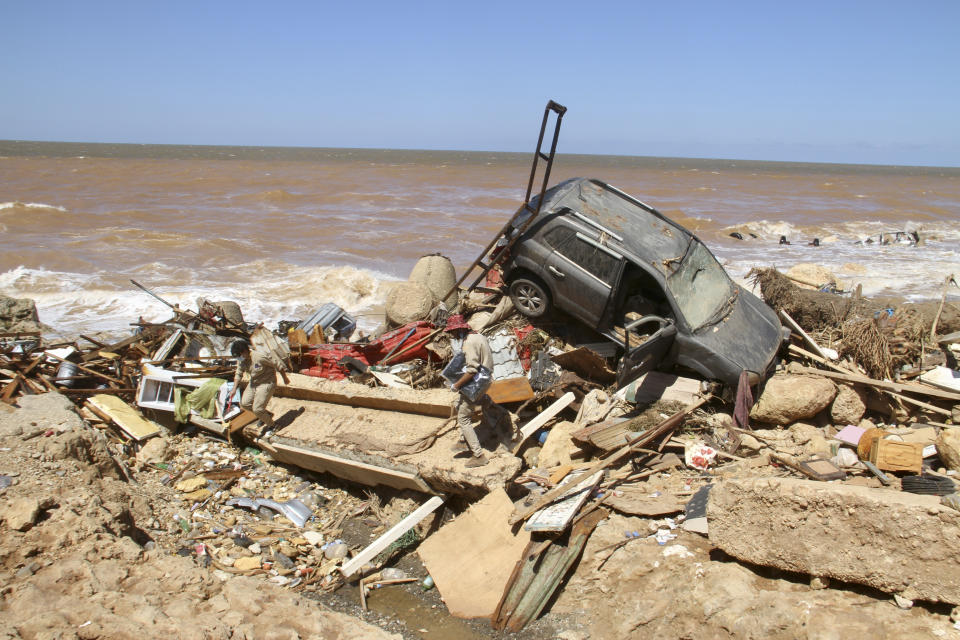
Damage from massive flooding is seen in Derna, Libya. Sept.13, 2023.
Damage from massive flooding is seen in Derna, Libya. Sept.13, 2023.
(Yousef Murad/AP Photo)
The dams held back millions of cubic meters of water, weighing millions of tons.
“Combine that weight with moving downhill, and it can produce enormous power,” BBC News reported. “Witnesses have said that the waters were nearly three metres [9.8 feet] in places.”
“It is estimated that six inches (20cm) of fast moving flood-water is enough to knock someone off their feet, and 2ft (60cm) is enough to float a car. So it is no surprise that whole buildings were taken out in the floods.”
Read more on Yahoo News, Libya floods: Why damage to Derna was so catastrophic, via BBC News
The dams held back millions of cubic meters of water, weighing millions of tons.
“Combine that weight with moving downhill, and it can produce enormous power,” BBC News reported. “Witnesses have said that the waters were nearly three metres [9.8 feet] in places.”
“It is estimated that six inches (20cm) of fast moving flood-water is enough to knock someone off their feet, and 2ft (60cm) is enough to float a car. So it is no surprise that whole buildings were taken out in the floods.”
Read more on Yahoo News, Libya floods: Why damage to Derna was so catastrophic, via BBC News
Climate change
In this photo provided by Turkey's IHH humanitarian aid group, rescuers retrieve the body of a flooding victim in Derna, Libya, Wednesday, Sept.13, 2023. (IHH via AP)
Warmer air holds more moisture and causes more evaporation, so climate change is making the water cycle more extreme and increasing the intensity of rain storms, scientists say. Studies have also shown that hurricanes are made stronger by warmer sea water that results from climate change.
The Associated Press reported that the extreme rain from Storm Daniel “is the latest extreme weather event to carry some of the hallmarks of climate change, scientists say. Daniel… drew enormous energy from extremely warm sea water. And a warmer atmosphere holds more water vapor that can fall as rain, experts said.”
Yahoo News asked Ricardo Pires, a spokesperson for UNICEF, the United Nations’ humanitarian aid agency three questions about what caused the situation in Libya and how such tragedies can be prevented in the future.
1. How and why did Hurricane Daniel cause such devastating destruction in Libya?
On Monday, Storm Daniel unfurled across eastern Libya, affecting most of the region but especially the areas of Al Bayda, Al Marj and Derna. It destroyed buildings, including schools and hospitals, and burst two crucial dams, adding even more water to already flooded streets.
We know about 664,000 people, including almost 300,000 children, live in the region, and many are now struggling to stay safe, find family members or care for their children.
The Mediterranean storm caused such devastation because it hit areas where already vulnerable communities live, following over a decade of conflict. For the children and families of Libya, it is yet another catastrophe.
2. Is being hit with a hurricane of this magnitude unusual for Libya? Is it related to climate change?
Storm Daniel caused more than 400mm — or 16 inches — of rain in just 24 hours, according to the World Meteorological Organization. That is significantly higher than the level of rainfall the region normally collects at this time of year and Libya's National Meteorological Centre said it was a new rainfall record.
While the storm carries all the hallmarks of climate change, it’s too soon to definitively link the two. But it’s safe to say, as the United Nations Secretary-General António Guterres has, that as the planet warms we can expect to see more intense storms, which lead to more severe flooding. The disaster in Libya is one of a series of extreme flooding events which have caused death and destruction around the world in recent months, including in Greece, Brazil and Hong Kong.
3. How can countries be better prepared for natural disasters such as this?
With extreme weather events increasing in frequency and intensity, governments must invest in better warning systems and infrastructure to protect vulnerable populations with incredible urgency.
It is essential that we safeguard the health, safety, learning and opportunities of every child by adapting the critical social services they rely on such as water and sanitation, health, education, nutrition, social protection and child protection services and infrastructure so they are resilient to the impacts of disasters. Unfortunately, adaptation and resilience building remains critically underfunded and under-resourced. It’s high time we increase the funds allocated towards this important work and prioritize children as we allocate them.
The Early Warnings for All campaign launched by Guterres is also essential. Early warnings and adaptation save lives. Further delay means death.
Explainer
What are medicanes? The ‘supercharged’ Mediterranean storms that could become more frequent
The flash flood that has killed thousands of people in Libya this week followed the ‘medicane’ storm Daniel
Agence France-Presse
The flash flood that has killed thousands of people in Libya this week followed a “medicane”, a rare but destructive weather phenomenon that scientists believe will intensify in a warming world.
The term is an amalgamation of the words Mediterranean and hurricane. Used by scientists and weather forecasters, it is less well known to the wider public.
Medicanes, which tend to form over parts of the Mediterranean Sea near the north African coast, are similar to hurricanes and typhoons although they can develop over cooler waters.

Destruction of Derna: why was flooding so bad in Libyan port city?
Read more
They can also bear a physical resemblance on satellite imagery as a swirling mass of storm clouds surrounding an eye in the middle.
Fierce winds and rain are unleashed; Storm Daniel dumped approximately 170 millimetres of rain in Libya. This will intensify with global warming, scientists say.
“We are confident that climate change is supercharging the rainfall associated with such storms,” said University of Reading professor Liz Stephens.
The Mediterranean cyclones are usually smaller and weaker than their tropical equivalents and have a smaller space in which to develop.
Their peak strength is usually the equivalent of a Category 1 hurricane on the Saffir-Simpson scale, encompassing speeds of 119-153km (74-95 miles) per hour.
Medicanes tend to form in the autumn when the sea is warm, usually in the western Mediterranean and the region between the Ionian Sea and the north African coast, explained Suzanne Gray, a professor at the University of Reading’s meteorology department.
A layer of colder air from higher altitudes forms convections with warmer air rising from the sea that converge around a centre of low pressure.
Medicanes form once or twice per year on average, according to the US National Oceanic and Atmospheric Administration.
While hurricanes move from east to west, medicanes tend to go from west to east.
Before striking Libya, Daniel pummelled Bulgaria, Greece and Turkey last week.
Three medicanes occurred off Greece between 2016 and 2018, while in 2019 Spanish weather services identified one between the Balearic Islands and the Algerian coast.
A medicane packing winds of up to 120 kilometres per hour, dubbed Ianos, lashed Greece in September 2020, killing three people in the city of Karditsa and triggering floods, landslides and power cuts.
The Italian island of Sicily was also struck in 2021.
In 2020, French weather monitor Meteo-France said it was difficult to work out climate signals from medicanes due to their rarity.
While scientists are increasingly able to unpick the likely effect of climate change on the probability of an extreme weather event happening and its intensity, no such attribution study has yet been carried out on Daniel.
In general, experts say the warming of sea surface temperatures, driven by human-induced climate change, is going to make extreme storms more intense.
Oceans have absorbed 90% of the excess heat produced by human activity since the dawn of the industrial age, according to scientists.
Spanish researchers said the Mediterranean reached its highest temperature on record in July as Europe baked under a series of heatwaves.
The surface waters of the eastern Mediterranean and Atlantic are two to three degrees Celsius warmer than usual, which would have turbocharged Daniel.
“The fact that Daniel could form into a medicane … is likely a result of warmer sea surface temperatures and hence human-made climate change,” added climate scientist Karsten Haustein of Leipzig University in Germany.
What are medicanes? The ‘supercharged’ Mediterranean storms that could become more frequent
The flash flood that has killed thousands of people in Libya this week followed the ‘medicane’ storm Daniel
Agence France-Presse
Fri 15 Sep 2023
The flash flood that has killed thousands of people in Libya this week followed a “medicane”, a rare but destructive weather phenomenon that scientists believe will intensify in a warming world.
The term is an amalgamation of the words Mediterranean and hurricane. Used by scientists and weather forecasters, it is less well known to the wider public.
Medicanes, which tend to form over parts of the Mediterranean Sea near the north African coast, are similar to hurricanes and typhoons although they can develop over cooler waters.

Destruction of Derna: why was flooding so bad in Libyan port city?
Read more
They can also bear a physical resemblance on satellite imagery as a swirling mass of storm clouds surrounding an eye in the middle.
Fierce winds and rain are unleashed; Storm Daniel dumped approximately 170 millimetres of rain in Libya. This will intensify with global warming, scientists say.
“We are confident that climate change is supercharging the rainfall associated with such storms,” said University of Reading professor Liz Stephens.
The Mediterranean cyclones are usually smaller and weaker than their tropical equivalents and have a smaller space in which to develop.
Their peak strength is usually the equivalent of a Category 1 hurricane on the Saffir-Simpson scale, encompassing speeds of 119-153km (74-95 miles) per hour.
Medicanes tend to form in the autumn when the sea is warm, usually in the western Mediterranean and the region between the Ionian Sea and the north African coast, explained Suzanne Gray, a professor at the University of Reading’s meteorology department.
A layer of colder air from higher altitudes forms convections with warmer air rising from the sea that converge around a centre of low pressure.
Medicanes form once or twice per year on average, according to the US National Oceanic and Atmospheric Administration.
While hurricanes move from east to west, medicanes tend to go from west to east.
Before striking Libya, Daniel pummelled Bulgaria, Greece and Turkey last week.
Three medicanes occurred off Greece between 2016 and 2018, while in 2019 Spanish weather services identified one between the Balearic Islands and the Algerian coast.
A medicane packing winds of up to 120 kilometres per hour, dubbed Ianos, lashed Greece in September 2020, killing three people in the city of Karditsa and triggering floods, landslides and power cuts.
The Italian island of Sicily was also struck in 2021.
In 2020, French weather monitor Meteo-France said it was difficult to work out climate signals from medicanes due to their rarity.
While scientists are increasingly able to unpick the likely effect of climate change on the probability of an extreme weather event happening and its intensity, no such attribution study has yet been carried out on Daniel.
In general, experts say the warming of sea surface temperatures, driven by human-induced climate change, is going to make extreme storms more intense.
Oceans have absorbed 90% of the excess heat produced by human activity since the dawn of the industrial age, according to scientists.
Spanish researchers said the Mediterranean reached its highest temperature on record in July as Europe baked under a series of heatwaves.
The surface waters of the eastern Mediterranean and Atlantic are two to three degrees Celsius warmer than usual, which would have turbocharged Daniel.
“The fact that Daniel could form into a medicane … is likely a result of warmer sea surface temperatures and hence human-made climate change,” added climate scientist Karsten Haustein of Leipzig University in Germany.
Libyans call for inquiry as fury grows over death toll from catastrophic floods
Attorney general asked to investigate amid allegations warnings ignored about dangerous state of two dams
Patrick Wintour Diplomatic editor
Libya: bodies pulled from sea as country reels from deadly flooding – video report
Accusations are being made that officials from the Libyan National Army security directorate may be trying to cover up that as Storm Daniel hit on Sunday night its officials went on TV to instruct citizens to stay in their homes under curfew rather than evacuate.
Wolfram Lacquer, a German-based Libya specialist, said however that it seemed clear that the local police met the mayor on Sunday as the storm approached and that messages were then broadcast from vans across the town calling for an evacuation of areas likely to be affected, but the call may have been met with reluctance.
He said it appeared no maintenance had been carried out on the dam nearest the city since 2011, and money that had been allocated had not been used. Many overseas contractors did not return to Libya after 2011, either because they were pursuing compensation claims or did not regard the country as safe.
“Already, we can see the key political protagonists – the rival governments and Haftar – expend a lot of effort on shaping public perceptions on who is responding and providing assistance. Menfi, for instance, called for the inquiry on the cause of the dam’s collapse to cover any evidence of the obstruction to aid reaching Derna,” Lacquer said.
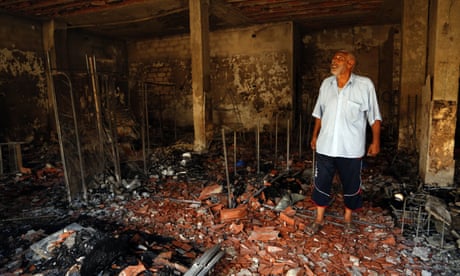
Libyans have lost faith in political class, US diplomat says after Tripoli clashes
The core of the two aggregate dams is made of compacted clay, and the sides are made of stones and rocks. Al-Bilad dam, which is about 1km south of the heart of the city, has a storage capacity of about 1.5m cubic metres, while Abu dam, about 13km south of the first dam, has a capacity of about 22.5m cubic metres.
In Derna, the beach was littered with possessions swept out of homes by the torrent that developed at a speed as water poured down from the Green mountains into the river.
The floods have displaced at least 30,000 people in Derna, according to the International Organization for Migration, and damaged or destroyed many access roads to Derna. Local authorities were able to clear some routes, and humanitarian convoys have been able to enter the city.
Rescue teams have arrived in Libya from Egypt, Tunisia, the United Arab Emirates, Turkey and Qatar. Most have now reached the city. Turkey is sending a ship carrying equipment to set up two field hospitals, while Egypt has assembled a near army of rescue vehicles that were paraded in front of the country’s president, Abdel Fattah al-Sisi, before moving across the border.
Attorney general asked to investigate amid allegations warnings ignored about dangerous state of two dams
Patrick Wintour Diplomatic editor
THE GUARDIAN
Thu 14 Sep 2023

Libya’s attorney general has been asked by senior politicians to launch an urgent inquiry into the catastrophic floods that have killed tens of thousands of people, including into allegations local officials imposed a curfew on the night Storm Daniel struck.
The Libyan Red Crescent put the death toll at more than 11,000 people, with nearly 20,000 still missing, the highest estimate yet from an official source. It said almost 2,000 bodies were swept into the sea by the floods.
Officials in the port city of Derna including the mayor, Abdulmenam al-Ghaithi, believe 20,000 people may have died. At least 5,500 people have been confirmed dead.
Many have been buried in mass graves but one of the chief shortages in the city, apart from drinking water, is body bags required to prevent disease spreading from unburied bodies. Rescue teams have been able to enter the city and are scouring rubble and ruins left by the floods.
The call for the inquiry came separately from both sides of a country divided between rival eastern and western administrations: Libya’s presidential council chair, Mohamed al-Menfi, in the east, and the interim prime minister of the Tripoli-based government, Abdel Hamid Dabaiba. Menfi said he wanted the inquiry “to hold accountable everyone who made a mistake or neglected by abstaining or taking actions that resulted in the collapse of the city’s dams”.
Libya has been riven between parallel administrations for years, but the attorney general, Al-Siddiq Al-Sour, is one of the few officials left whose writ supposedly runs across the country.
A groundswell of anger is building about whether warnings about the state of the two dams were ignored, the failure to find new contractors to maintain the dam after Libya’s 2011 civil war, and the precise instructions issued by the police and security directorate on the night of the flood.
A Turkish firm, Arsel, had been contracted to work on the dams in 2007 but left Libya in 2011 when fighting broke out and had not returned. Part of a sum of 39m dinars set aside for the dam’s maintenance in 2003 was later taken back from the ministry of water resources. After the company left the country, its machinery was stolen and the building site went into disuse, according to information that was shared with Dabaiba at a meeting with the ministry.

Libya’s attorney general has been asked by senior politicians to launch an urgent inquiry into the catastrophic floods that have killed tens of thousands of people, including into allegations local officials imposed a curfew on the night Storm Daniel struck.
The Libyan Red Crescent put the death toll at more than 11,000 people, with nearly 20,000 still missing, the highest estimate yet from an official source. It said almost 2,000 bodies were swept into the sea by the floods.
Officials in the port city of Derna including the mayor, Abdulmenam al-Ghaithi, believe 20,000 people may have died. At least 5,500 people have been confirmed dead.
Many have been buried in mass graves but one of the chief shortages in the city, apart from drinking water, is body bags required to prevent disease spreading from unburied bodies. Rescue teams have been able to enter the city and are scouring rubble and ruins left by the floods.
The call for the inquiry came separately from both sides of a country divided between rival eastern and western administrations: Libya’s presidential council chair, Mohamed al-Menfi, in the east, and the interim prime minister of the Tripoli-based government, Abdel Hamid Dabaiba. Menfi said he wanted the inquiry “to hold accountable everyone who made a mistake or neglected by abstaining or taking actions that resulted in the collapse of the city’s dams”.
Libya has been riven between parallel administrations for years, but the attorney general, Al-Siddiq Al-Sour, is one of the few officials left whose writ supposedly runs across the country.
A groundswell of anger is building about whether warnings about the state of the two dams were ignored, the failure to find new contractors to maintain the dam after Libya’s 2011 civil war, and the precise instructions issued by the police and security directorate on the night of the flood.
A Turkish firm, Arsel, had been contracted to work on the dams in 2007 but left Libya in 2011 when fighting broke out and had not returned. Part of a sum of 39m dinars set aside for the dam’s maintenance in 2003 was later taken back from the ministry of water resources. After the company left the country, its machinery was stolen and the building site went into disuse, according to information that was shared with Dabaiba at a meeting with the ministry.

There are allegations officials imposed a curfew on the night the dams collapsed. Photograph: Jamal Alkomaty/AP
Any inquiry would need to examine the circumstances that led to the arrest of the leading candidate to win Derna’s municipal elections, resulting in the elections, scheduled for September, being cancelled and leaving the city under the control of military officials. Derna has been through a variety of different administrations, but the overall area is under the control of the Libyan National Army, led by the authoritarian Gen Khalifa Haftar and his sons.
International aid started to reach the town on Wednesday afternoon, after delays partly caused by disruption of internet access and impassable roads. In all, rescue workers managed to extract 39 people from the rubble on Wednesday, including an entire family. Social media including Facebook were used to broadcast the whereabouts of those needing rescue.
Any inquiry would need to examine the circumstances that led to the arrest of the leading candidate to win Derna’s municipal elections, resulting in the elections, scheduled for September, being cancelled and leaving the city under the control of military officials. Derna has been through a variety of different administrations, but the overall area is under the control of the Libyan National Army, led by the authoritarian Gen Khalifa Haftar and his sons.
International aid started to reach the town on Wednesday afternoon, after delays partly caused by disruption of internet access and impassable roads. In all, rescue workers managed to extract 39 people from the rubble on Wednesday, including an entire family. Social media including Facebook were used to broadcast the whereabouts of those needing rescue.
Derna citizens had been very aware of the threat posed by the state of the dams
and the Wadi Derna River that runs through the city with no embankment.02:02
Libya: bodies pulled from sea as country reels from deadly flooding – video report
Accusations are being made that officials from the Libyan National Army security directorate may be trying to cover up that as Storm Daniel hit on Sunday night its officials went on TV to instruct citizens to stay in their homes under curfew rather than evacuate.
Wolfram Lacquer, a German-based Libya specialist, said however that it seemed clear that the local police met the mayor on Sunday as the storm approached and that messages were then broadcast from vans across the town calling for an evacuation of areas likely to be affected, but the call may have been met with reluctance.
He said it appeared no maintenance had been carried out on the dam nearest the city since 2011, and money that had been allocated had not been used. Many overseas contractors did not return to Libya after 2011, either because they were pursuing compensation claims or did not regard the country as safe.
“Already, we can see the key political protagonists – the rival governments and Haftar – expend a lot of effort on shaping public perceptions on who is responding and providing assistance. Menfi, for instance, called for the inquiry on the cause of the dam’s collapse to cover any evidence of the obstruction to aid reaching Derna,” Lacquer said.

Libyans have lost faith in political class, US diplomat says after Tripoli clashes
The core of the two aggregate dams is made of compacted clay, and the sides are made of stones and rocks. Al-Bilad dam, which is about 1km south of the heart of the city, has a storage capacity of about 1.5m cubic metres, while Abu dam, about 13km south of the first dam, has a capacity of about 22.5m cubic metres.
In Derna, the beach was littered with possessions swept out of homes by the torrent that developed at a speed as water poured down from the Green mountains into the river.
The floods have displaced at least 30,000 people in Derna, according to the International Organization for Migration, and damaged or destroyed many access roads to Derna. Local authorities were able to clear some routes, and humanitarian convoys have been able to enter the city.
Rescue teams have arrived in Libya from Egypt, Tunisia, the United Arab Emirates, Turkey and Qatar. Most have now reached the city. Turkey is sending a ship carrying equipment to set up two field hospitals, while Egypt has assembled a near army of rescue vehicles that were paraded in front of the country’s president, Abdel Fattah al-Sisi, before moving across the border.
